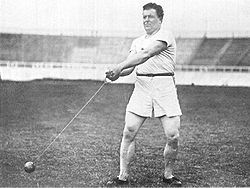Contents
| Men's hammer throw at the Games of the IV Olympiad | ||||||||||
|---|---|---|---|---|---|---|---|---|---|---|
 The winner John Flanagan | ||||||||||
| Venue | White City Stadium | |||||||||
| Date | July 14, 1908 | |||||||||
| Competitors | 19 from 8 nations | |||||||||
| Winning distance | 51.92 OR | |||||||||
| Medalists | ||||||||||
| ||||||||||
| Athletics at the 1908 Summer Olympics | |
|---|---|
| | |
| Track events | |
| 100 m | men |
| 200 m | men |
| 400 m | men |
| 800 m | men |
| 1500 m | men |
| 5 miles | men |
| 110 m hurdles | men |
| 400 m hurdles | men |
| 3200 m steeplechase | men |
| Medley relay | men |
| 3 mile team race | men |
| Road events | |
| Marathon | men |
| 3500 m walk | men |
| 10 mile walk | men |
| Field events | |
| Long jump | men |
| Triple jump | men |
| High jump | men |
| Pole vault | men |
| Standing long jump | men |
| Standing high jump | men |
| Shot put | men |
| Discus throw | men |
| Hammer throw | men |
| Javelin throw | men |
| Greek discus | men |
| Freestyle javelin | men |
| Tug of war | men |
The men's hammer throw was one of six throwing events on the Athletics at the 1908 Summer Olympics programme in London. The competition was held on July 14, 1908. 19 throwers from eight nations competed. [1] NOCs could enter up to 12 athletes. [2] The event was won by American John Flanagan, his third consecutive victory in the event. He was the first man to win three medals in the hammer throw and, as of the 2016 Games, the only one to win three gold medals in the event. The silver medal went to fellow American Matt McGrath. Con Walsh of Canada took bronze and became the first athlete not from the United States to win a medal in the event, as the Americans had swept the podium in both 1900 and 1904. The three medalists were all part of the Irish Whales.